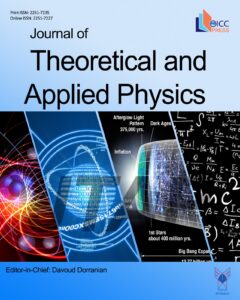Exploring elastic mechanics and radiation shielding efficacy in neodymium(III)-enhanced zinc tellurite glasses: A theoretical and applied physics perspective
Authors
-
Hesham M. H. Zakaly
*
 1, 2, 3
1, 2, 3
- Yasser S. Rammah 4
- Shams A. M. Issa 5
- Nouf Almousa 6
- Adel M. El-Refaey 7
- Mohamed Said Shams 8
Abstract
The present work scrutinizes the radiation protection features and mechanical characteristics of neodymium zinc-tellurite of composition [(TeO2)70-(ZnO)30]1-x –(Nd2O3)x: x= 0-5 mol% in steps of 1 (TZNd1 – 5). The Makishima–Mackenzie’s model was adopted for the computation of the Poisson’s ratio (PR) and elastic moduli. WinXcom and EXABCal software’s were performed to evaluate the radiation shielding parameters and buildup factors, respectively of TZNd-glasses. Results revealed that the increasing of Nd2O3 concentration in TZNd-glasses from 1 to 5 mol% had a positive effect on their elastic parameters: Young’s modulus increased from 53.13 to 54.81GPa, bulk modulus changed from 31.95-33.65 GPa, and the PR varied from 0.222 to 0.228 for TZNd1 to TZNd5. There was a small increase in the Z/A as the Nd content increased, which leads to slight increase in TMSP of the particles. The mass attenuation coefficient increased in the order TZNd1< TZNd2< TZNd3 < TZNd4 < TZNd5. The maximum value of LAC obtained at 15 keV were 246, 249, 253, 257, and 260 cm-1 for TZNd1, TZNd2, TZNd3, TZNd4, and TZNd5, respectively. The HVT varies inversely with the linear attenuation coefficient. Throughout the considered energy spectrum the range of for the glasses varied from 22.65 – 40.22, 22.64 – 40.25, 22.64 – 40.29, 22.63 – 40.32, and 22.63 – 40.36 for TZNd1, TZNd2, TZNd3, TZNd4, and TZNd5, respectively. The values of fast neutron removal cross section showed a steady increase as the partial densities of Nd and oxygen of the TZNd-glass systems increased. Generally, one can conclude that the additive of Nd2O3 to TeO2-ZnO glasses leads to enhance their mechanical properties and increase their ability to absorb neutron and photon to apply in nuclear medicine applications.



